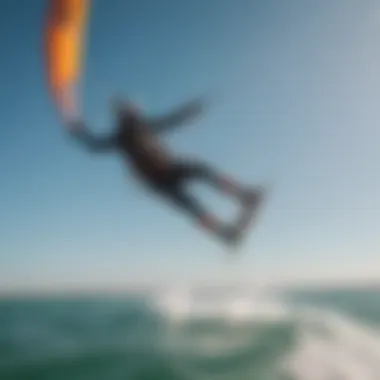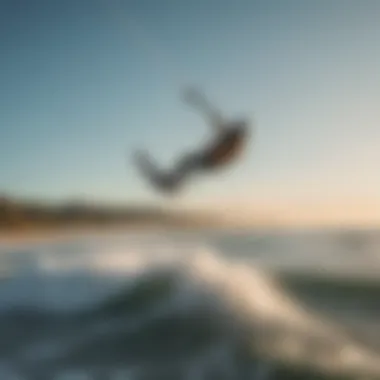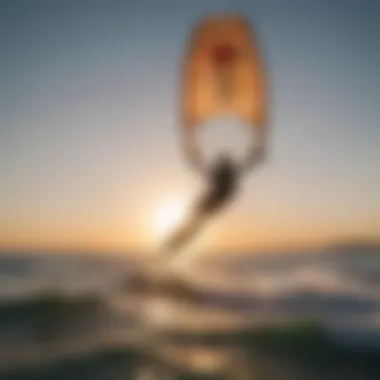Top Kite Brands Explored: An In-Depth Guide


Intro
The thrilling world of kiteboarding is not just a sport; it's a blend of art, science, and a wee bit of magic. For those who seek to dance with the wind and glide over the waters, navigating through the myriad of kite brands can feel overwhelming. Each brand touts its innovations and promises of top-notch performance, but how does one sift through the marketing haze to find what truly resonates? This article aims to untangle that knot by delving into the key players in the kiteboarding industry. Here, we’ll explore the characteristics that distinguish these brands, the performance metrics that matter most, and how they cater to different skill levels and personal preferences.
In the following sections, we will also touch on technological advancements that propel these brands forward, the sustainability practices being implemented, and the sentiments of kiteboarders who have experienced these products first-hand. This comprehensive guide ultimately aims to equip enthusiasts—regardless of their experience level—with the insights needed to make informed choices in a market that evolves as quickly as a gust of wind.
Gear Selection
Choosing the right gear is the cornerstone of an enjoyable kiteboarding experience. With the right equipment, one can seamlessly transition from novice to expert, carving through the waves with confidence.
Types of Kites
Kites vary widely based on their design, purpose, and target audience. The main types include:
- Delta Kites: Known for their stability and ease of handling, delta kites are often favored by beginners. Their shape allows for a smoother ride, making them ideal for those just getting started.
- C Kites: With a design that allows for powerful boosts and excellent upwind performance, C kites appeal more to intermediate and advanced riders. They require more skill to handle but reward the rider with thrilling speed and agility.
- Bow Kites: These kites combine the best of both worlds, offering a broad wind range and superb control, making them suitable for all skill levels.
- Foil Kites: Primarily used for backcountry snowkiting or landboarding, foil kites are highly efficient and lightweight. Their design allows for versatility but comes with a steeper learning curve.
Choosing the Right Board
Selecting a kiteboard is equally crucial. The type of board you choose can significantly enhance your overall kiteboarding experience. Here are a few considerations:
- Size: Larger boards provide more surface area, which means better control in light winds. Conversely, smaller boards are better for speed and technical maneuvers.
- Shape: The rocker shape affects how the board rides through the water. A flatter shape gives more speed, while more rocker allows for better handling in chop.
- Flex: Stiffer boards are often faster and more responsive, while boards with more flex offer a smoother ride and greater shock absorption on landings.
Each rider has a unique style, so experimenting with different gear is key to finding what suits you best. Ultimately, understanding the nuances between these options can make the difference between a mundane day on the water and a session that’s etched in memory.
"The right gear can transform a good day into a great one. Always consider your personal style and the conditions you'll face."
Intro to Kite Brands
Kiteboarding is not just a sport; it's a blend of artistry and adrenaline that finds its expression through the equipment used—mainly the kites. The importance of understanding kite brands cannot be overstated. Different brands cater to varying needs, styles, and levels of experience. For both novices and seasoned riders, the choice of brand can significantly impact performance on the water, safety, and overall enjoyment of the activity.
Understanding Kiteboarding Equipment
At its core, kiteboarding equipment encompasses more than just the kite. It includes the board, control systems, harnesses, and safety gear. Each component works in harmony to give the rider an exhilarating experience.
- Kites: These come in various shapes and sizes, designed for specific conditions and riding styles, from single-line kites meant for training to performance-oriented models.
- Boards: The type of board matters greatly. Freestyle boards differ significantly from those used for wave riding, while light wind boards provide versatility.
- Control Gear: The harness, lines, and bars are crucial for ensuring effective maneuverability.
It's essential for riders to grasp the specifications and technology behind each piece of equipment. This knowledge helps in making informed decisions that suit their individual styles and preferences.
As an example, a beginner might lean towards brands that offer user-friendly kites with quick response features, while an expert might look for advanced kites that excel in high winds.
The Evolution of Kite Design
Over the years, kite design has undergone a remarkable transformation. Initially, kites were rudimentary, often hand-crafted. Fast forward to today, and technology has revolutionized the construction and performance of kites.
Key highlights in the evolution include:
- Material Advancements: Early kites were often bulky and heavy, while modern materials like ripstop nylon have reduced weight and increased durability.
- Shape and Size Variations: Designers have experimented with kite shapes, leading to innovations such as delta, bow, and hybrid kites. Each shape offers unique benefits, impacting lift and stability.
- Inflation and Control Systems: The introduction of one-point inflation systems drastically reduces setup time. Advanced control systems provide responsive steering and safety features that have grown in sophistication.
"The evolution of kite design reflects the advances in technology and the needs of riders, ensuring that even in challenging conditions, performance never lags."
Understanding these design changes is vital for choosing the right kite for one's needs. The generational shifts in kite technology have opened the door for a broader audience, making kiteboarding more accessible than ever before.
In summary, demystifying kite brands and their products calls for a keen awareness of how equipment affects performance. This introduction lays the groundwork for appreciating the specifics of kite brands, setting the stage for a comprehensive exploration of the top names in the industry.
Criteria for Evaluating Kite Brands
Choosing the right kite brand can feel as tricky as untangling a mess of lines on a breezy beach day. This section peels back the layers on what makes kite brands stand out, helping you navigate the crowded waters of kiteboarding choices. Evaluating kite brands isn't merely a checkbox exercise; it’s about understanding key metrics that tie directly into your performance, safety, and overall experience on the water.
Performance and Reliability
When it comes to kiteboarding, performance isn't just a lofty term tossed around by marketing teams; it’s the heartbeat of your ride. Each kite’s ability to handle the wind, response during turns, and stability in various conditions ultimately dictate how well you can perform on the water. A trustworthy kite brand typically demonstrates reliable performance metrics that prove themselves time and again in diverse environments.
Consider the following factors:
- Wind Range: A good kite covers a robust wind range, adapting to lighter and stronger winds without compromising stability.
- Response Time: Kites that promptly respond to steering input provide better control, crucial when navigating tricky conditions.
- Durability: Reliable materials and construction ensure that kites can withstand the wear and tear of being out in the elements.
Performance isn’t just for pros; even amateurs should consider it, as reliable kites can boost confidence and safety as riders learn.
Variety in Product Range
Not all kiteboarders are cut from the same cloth, and that's exactly where variety in product range comes into play. Some brands offer kites specifically designed for tricks, while others focus on stability or beginner-friendly features. This diversity allows every rider to find their sweet spot. A well-established brand tends to have multiple models catering to various abilities and styles, thus enhancing the overall kiteboarding experience.
Key points to consider include:
- Different Types of Kites: Look for brands that provide options like C-kites for freestyle or bow kites for beginners.
- Accessories and Gear: Quality brands usually offer a full suite of related products, such as bars, lines, and safety gear.
- Targeted Experiences: Some brands create kites designed for specific conditions and riding styles, allowing for tailor-made adventures.


Customer Support and Warranty
Nobody enjoys the sinking feeling of buying something only to discover there’s no support if things go awry. A solid customer support system and comprehensive warranty can be the lifebuoys in that unpredictable sea of kiteboarding mishaps. When evaluating brands, take the time to look into how they handle inquiries and product issues.
Things to keep in mind:
- Warranty Length: Kites that come with longer warranties can indicate a manufacturer’s confidence in their product.
- Accessibility: Brands should make it easy to reach customer service through multiple channels, be it chat, email, or phone.
- Feedback: Look for brands that encourage testimonials and feedback—this suggests a commitment to continuous improvement and customer satisfaction.
The better the support, the less stress you’ll face on your kiteboarding journey.
By carefully evaluating these elements, you will arm yourself with the knowledge necessary to make a well-informed choice. Whether you’re zipping across the waves or cruising along the shoreline, knowing what to look for in a kite brand can turn your kiteboarding experience from good to exceptional.
Top Kite Brands Overview
In the world of kiteboarding, selecting the right equipment can make or break your experience on the water. Understanding the top kite brands gives riders valuable insights into their choices, potentially influencing their progression and enjoyment. Not only do these brands vary in their kite designs and performance capabilities, but they also cater to different skill levels, styles, and preferences.
Choosing the right brand is akin to selecting a trusted ally for your adventures. Each brand has its own flair, driving innovation and pushing the envelope in kite design and functionality. Factors such as durability, wind conditions, and rider style should be at the forefront of a consumer's mind. This overview will illuminate critical attributes of each prominent brand, ensuring enthusiasts have a solid foundation in navigating the market.
Brand A: [Brand Name]
Key Features of Brand A
Brand A is recognized for its unparalleled high-performance kites that excel in a variety of wind conditions. The kites often utilize advanced materials, striking the perfect balance between weight and durability. This characteristic becomes crucial when riders are faced with unpredictable weather.
One standout feature is its turbo inflation system, designed for quick setup, allowing riders to hit the water without unnecessary delays. This can have enormous benefits, especially on days when the wind is finicky. The safety features are also commendable, incorporating intuitive release systems and reinforced stitching — appealing elements for both beginners and seasoned riders alike.
Target Demographic
Brand A primarily targets intermediate to advanced kiteboarders. Those who seek high-octane performance and enjoy experimenting with tricks will find these products align closely with their aspirations. The adaptability of these kites in diverse conditions is often the selling point for videos and demos.
However, newcomers might find the advanced features a bit overwhelming, leading to a steeper learning curve. Therefore, assessing one's riding level is paramount before plunging into this brand's offerings.
Brand Philosophy
Brand A prides itself on a performance-driven philosophy, focusing on creating equipment that offers exceptional ride experiences. The commitment to quality and customer satisfaction resonates well among users, earning the brand a solid reputation in the kiteboarding community.
This philosophy emphasizes not just business profit but also a love for the sport, encouraging innovation for the thrill-seeking crowd. However, while many appreciate this ethos, some hardcore users have expressed a desire for a more extensive product range to cater to different riding styles.
Brand B: [Brand Name]
Key Features of Brand B
Distinguished for their unique blend of affordability and quality, Brand B provides kites that are excellent for those looking to delve into the sport without breaking the bank. These kites typically come with well-balanced designs that cater well to various skill levels.
A particularly appealing feature is the customization options available, which allow users to tailor their kites according to personal preferences. This adaptability fosters a sense of ownership and connection to the craft, especially for novice riders eager to make their marks.
Target Demographic
Brand B primarily focuses on beginners and intermediate riders. Its approachable designs and price points make it a favorite for those who are just starting on their kiteboarding journeys. This brand captivates enthusiasts who prefer reliability and value over top-tier performance.
Nonetheless, those aiming for fierce competition may find the kites less suited to peak performance demands compared to other premium brands.
Brand Philosophy
Brand B’s philosophy revolves around accessibility and community. By focusing on producing high-quality kites at reasonable prices, this company aims to make kiteboarding enjoyable for all, promoting inclusivity in the sport. This commitment resonates particularly well in local communities and clubs.
However, while many laud this approach, some advanced users feel that Brand B lacks the cutting-edge innovations exhibited by competitors.
Brand C: [Brand Name]
Key Features of Brand
Brand C is known for pushing the boundaries of kite technology. One notable feature is their streamlined designs which are engineered for minimal drag and enhanced lift. A good example is their specialized leading edge design which ensures better control and stability in varying wind conditions.
This technology translates into performance benefits that can significantly impact a rider's ability to perform complex maneuvers while maintaining a level of comfort and safety.
Target Demographic
Often favored by seasoned professionals and competitive riders, Brand C delivers equipment that anticipates the needs of those who push the limits. This brand’s unique offerings entice riders looking for a competitive edge.
However, novices might experience challenges as maneuvering high-performance kites often requires a significant level of skill and understanding.
Brand Philosophy
The core philosophy of Brand C emphasizes innovation and the relentless pursuit of performance. By investing heavily in research and development, they aim to deliver products that surpass user expectations.
While this dedication to performance is applaudablenots, some customers have expressed concerns regarding their customer service accessibility, particularly during peak seasons.


Brand D: [Brand Name]
Key Features of Brand
Brand D is synonymous with exceptional durability, utilizing robust materials to withstand the rigors of frequent use. This plays a vital role in enhancing longevity and reliability, a crucial factor for serious kiteboarders who spend ample time on the water.
An interesting feature here is the double seam technology, which reinforces kite structure, providing extra peace of mind, especially under intense conditions.
Target Demographic
Brand D appeals primarily to recreational and intermediate kiteboarders who value durability over frills. Families and schools frequently reach for this brand for its dependable performance, especially on those long weekend outings.
On the flip side, advanced riders might find Brand D’s products lacking the cutting-edge performance features they seek.
Brand Philosophy
The philosophy of Brand D revolves around building trust through quality. They cultivate a loyal customer base that appreciates products designed for longevity and reliability, which is built upon solid craftsmanship. Nonetheless, this focus does result in a lesser emphasis on frequent innovations compared to other brands.
Brand E: [Brand Name]
Key Features of Brand E
Brand E makes waves in the kiteboarding scene with its light-weight construction and flexible designs that truly enhance maneuverability. The user-friendly nature of these kites shines through, particularly with their intuitive controls and performance curves designed for smooth riding.
They often come equipped with adjustable bar settings, allowing riders to match their kites to shifting wind conditions seamlessly.
Target Demographic
The brand targets those looking for versatility—beginners to advanced riders who appreciate a balance of performance and ease of use. This broad appeal makes them a go-to brand at many kiteboarding schools.
However, the lightweight features might lead to durability concerns in extreme use cases, so riders should be wise about their session conditions.
Brand Philosophy
Brand E’s philosophy is rooted in designing kites that empower riders. The brand focuses on helping users develop their skills, providing tools that promote growth in kiteboarding. This community-centric approach has solidified their standing within various riding communities.
Despite their focus on empowerment, some riders might argue that this philosophy sometimes overlooks demanding performance needs when adrenaline is on the line.
Technological Innovations in Kite Design
In the ever-evolving world of kiteboarding, keeping up with the latest technological innovations is key for both safety and performance. These advancements not only enhance the experience on the water but also significantly contribute to the skill development of riders. As more kite brands enter the market, the need for innovation becomes increasingly essential. The technologies implemented in kite design affect everything from materials to flying dynamics, making them vital details for kiteboarders to comprehend.
Materials and Durability
The selection of materials in kite construction nowadays is quite impressive. Brands have shifted from traditional fabrics to modern composites which offer both strength and lightness. What this means in practical terms is that kites can handle wear and tear longer without the risk of tearing or losing shape.
Common materials include high-tenacity ripstop nylon and polyesters, which add durability while keeping weight to a minimum.
- Benefits of Advanced Materials:
- Increased durability without compromising weight
- Resistance to UV rays and other environmental factors
- Better control over aerodynamics during flight
Imagine a kite made with older materials; it might be heavy and cumbersome. New innovations mean more complex designs can be created using advanced materials that are lighter yet tougher, allowing that adrenaline rush without the worry of equipment failure.
Inflation Systems
Next up are inflation systems, which are critical in how a kite performs right from takeoff. Many brands now use one-pump systems which efficiently inflate all sections of a kite simultaneously. This has transformed the preparation stage, making it much quicker and simpler for riders.
A reliable inflation system ensures:
- Quick Setup: Less time spent rigging and more time riding.
- Consistent Sail Shape: Uniform inflation leads to steady airflow, enhancing performance.
- Safety Measures: Many inflation systems incorporate features that prevent over-inflation, ensuring that kites maintain their integrity during flight.
"A good inflation system brings peace of mind. You know your kite is ready for action every time."
– An avid kiteboarder
Control System Advances
The control systems of kites have come a long way as well. Innovations in trimming and steering allow for improved handling and responsiveness. Riders can now fine-tune their experience with precision adjustments that make a world of difference in diverse conditions.
- Key Features:
- Adjustable bar pressure allows users to customize their control feel.
- Depower options give riders the ability to manage their power more effectively amidst changing winds.
The right control system allows for smooth transitions and precise movement, enabling riders to push their boundaries with confidence. This level of control also fosters safety, allowing users to react quickly in unexpected situations.
Overall, technological advancements in kite design not only improve the riding experience but also ensure that traditional kites evolve with the changing demands of the sport. By understanding these crucial innovations, kiteboarders can make informed choices, optimizing their equipment for maximum enjoyment.


Sustainability in Kiteboarding
Sustainability in kiteboarding is an increasingly relevant topic as the impact of outdoor sports on the environment becomes clearer. As kiteboarders, we often prioritize the thrill of harnessing the wind, yet it’s essential to be mindful about the processes and materials involved in our pastime. Recognizing this can lead to more eco-conscious decisions, aligning our passion with environmental stewardship. This approach not only safeguards our beloved beaches and oceans for future generations, but it can also enhance the overall kiteboarding experience through a deeper connection with nature.
Understanding the significance of sustainability can manifest in various ways, including the choice of materials, the manufacturing process, and the corporate practices of kite brands. The adoption of sustainable practices can lead to improved products that are not only more durable but also aligned with an environmentally friendly ethos. As kiteboarding continues to grow in popularity, the conversation around sustainability urges both brands and consumers to actively participate in preserving our planet's resources and ecosystems.
Eco-Friendly Materials
In recent years, kite brands have begun to explore eco-friendly materials that minimize environmental impact. Traditional kite materials often include synthetics such as polyester, but many companies are now looking towards more sustainable alternatives.
Some of these materials include:
- Recycled polyester: Made from recycled plastic bottles, this material helps to reduce waste while providing excellent durability.
- Organic cotton: Used in certain accessories and apparel, organic cotton is grown without harmful pesticides and is biodegradable.
- Biodegradable resins: These can be utilized in kite manufacturing, breaking down more readily in the environment than traditional materials.
These eco-friendly options not only indicate a brand's commitment to sustainability, but they also resonate with increasingly environmentally-aware consumers. As kiteboarders, choosing gear made from these materials represents a small yet powerful step towards reducing our carbon footprint.
Corporate Social Responsibility
Corporate social responsibility (CSR) within kiteboarding brands goes beyond simply offering eco-friendly products. It includes a broader commitment to ethical practices, social equity, and environmental protection. Some key considerations of CSR in this field include:
- Community Engagement: Leading brands often invest in local communities where they operate. This can involve sponsoring local events, supporting youth programs, or contributing to beach clean-ups. By engaging with communities, brands can foster a greater appreciation for the environmental challenges facing coastal areas.
- Supply Chain Transparency: Consumers are demanding clarity on how products are made and where materials come from. Brands that are transparent about their supply chains demonstrate integrity and accountability. Engaging in fair trade practices and ensuring that workers are treated ethically are also crucial elements of responsible manufacturing.
- Environmental Initiatives: Many companies actively participate in or fund projects that focus on habitat restoration and conservation efforts. This not only helps protect ecosystems but also promotes a positive brand image among environmentally conscious consumers.
"Every kite bought has a story. Choosing one with a good narrative about sustainability tells the world where our priorities lie".
By embracing sustainability, kiteboarding companies are signaling their commitment not just to enthusiasts, but also to the world at large. It fosters a culture of awareness that encourages all of us—kiteboarders, educators, and event organizers—to think critically about our choices and their impacts. In the end, selecting brands that prioritize sustainability enriches our experiences and helps cultivate a more resilient planet.
Consumer Feedback and Brand Reputation
In the world of kiteboarding, where thrills and performance meet, understanding consumer feedback and brand reputation holds significant weight. This section examines how customer experiences shape perceptions of kite brands and influence buying decisions. For potential buyers, especially those just dipping their toes into the sport, brand reputation acts as a beacon of reliability.
Consumer feedback, often accumulated through online reviews and word-of-mouth, yields invaluable insights about product quality and brand integrity. A kite that may shine on paper could falter in real-world scenarios if users report recurrent issues with durability or performance. Thus, serious kiteboarders must sift through these testimonials to inform their choices, as the collective voice of customers tends to paint a clearer picture than marketing jargon ever could.
Key Elements of Consumer Feedback
- Authenticity: Real experiences shared by users often reveal direct correlations to the product’s performance in various conditions.
- Community Influence: Kiteboarding is both an individual pursuit and a community activity. Recommendations from fellow enthusiasts serve as powerful endorsements, impacting decisions more than direct advertising.
- Long-Term Reliability: Many brand reputations are built over years, thus necessitating a deeper look into the long-term reliability of kite products through historical user reviews.
The importance of brand reputation goes beyond just one product—it is an ongoing journey of trust built between the manufacturer and the customer. A kite brand with a long-standing, positive reputation likely invests in quality assurance and customer satisfaction, making it a wise bet for those who crave adventure.
Customer Reviews Overview
When it comes to understanding which kite brand is right for you, diving into customer reviews provides a treasure trove of information. Reviews are like footprints left by other riders, guiding newcomers on their quest for the perfect kite.
- Diverse Perspectives: Reviews come from various riders, from beginners to seasoned veterans. This variety helps establish a benchmark for performance across different skill levels. Newbies may value ease of use while advanced riders might focus on maneuverability and speed.
- Honest Assessments: Users often share not only what they liked but also what they didn’t. A consistent mention of a recurring issue—like a brand's kites being hard to control during high winds—can be a red flag.
- Impact of Performance: How a kite performs in real-world conditions can be vastly different from controlled tests. Reviews can shed light on specific features like stability, lift, and user-friendliness during challenging conditions.
If you want to dig into firsthand accounts and gauge what the kiteboarding community thinks, websites like Reddit and specific kiteboarding forums can be a good starting point.
Industry Awards and Recognitions
Recognizing the prowess of kite brands often comes in the form of accolades and awards. These honors offer an additional layer of credibility while reflecting a brand’s commitment to innovation and quality.
- Performance Awards: Various kiteboarding events evaluate brands based on speed, agility, and control, awarding the top performers. Brands often feel a surge of confidence when they take home accolades, reinforcing their products' status.
- Design Acknowledgments: Awards recognizing innovative design can spotlight brands that push the envelope in terms of technology or eco-friendliness. Such recognitions often attract consumers keen on both performance and sustainability.
- User Choice Awards: Some awards are rooted in user popularity, gathered through extensive voting. When kiteboarders themselves vote a brand as their favorite, it can signal real-world appreciation beyond professional circles.
In summary, reviewing customer feedback and considering brand reputation is a vital step for anyone looking to purchase a kite. Alongside personal testimonies, awards can validate choices, allowing kiteboarders to invest not just in a product but in a legacy of performance.
Culmination: Selecting the Best Kite Brand for Your Needs
Choosing the right kite brand isn't just a matter of picking a name off a shelf; it's about aligning your personal aspirations, riding style, and skill level with what the brand has to offer. This article takes a hard look at what makes each of the top kite brands tick, digging into their distinct features, philosophies, and suitability for various kiteboarding conditions.
The critical takeaway here is that there isn’t a one-size-fits-all answer when it comes to selecting a kite brand. Each rider brings their own preferences and riding styles to the table, which means that evaluations should be based on individual needs rather than broad, generalized recommendations. Analyzing criteria such as performance, reliability, and customer support allows you to gauge which brands are truly worth your time and investment.
Consideration of sustainability practices has also become essential for many kiteboarders today. There is increasing awareness regarding environmental impact, and brands that prioritize eco-friendly materials aren’t just appealing to the environmentally conscious; they also show foresight into the future of this sport.
"A kite is more than just equipment; it’s a companion on your journey through the wind."
As we wrap this up, it’s clear that the path to finding the best kite brand for you involves thoughtful consideration of several elements, from the technical specifications of the kites to the overarching brand ethos. The ultimate goal is to enhance your riding experience while making informed decisions.
Matching Brands to Riding Styles
Every kiteboarder has their own unique sailing style, and different brands cater to these diversities. For example, if you are a freestyle enthusiast, brands like North Kiteboarding might catch your attention due to their specific designs that support advanced tricks and mobility. Conversely, if you prefer a steady, characteristic ride, brands such as Core or Cabrinha may deliver the reliability and performance you're after.
Interestingly, brand philosophies also play a role. Some brands concentrate on innovation and pushing the boundaries of kite tech—think Slingshot Kiteboarding—which can appeal more to advanced riders. Others might focus on providing beginner-friendly gear, perfect for those new to the sport. Here’s a brief rundown of how different brands might align with various riding styles:
- Freestyle: North, Slingshot
- Wave Riding: Naish, Cabrinha
- All-around: Core, RRD
- Light Wind: Best, F-One
Understanding how these brands fit into your riding style will help you make smarter, more effective choices as you gear up for your next adventure on the water.
Final Thoughts
To sum it up, the kiteboarding landscape is rich and varied, with plenty of reputable brands available. The ultimate decision comes down to personal fit. Face it, what works wonders for one rider may leave another just floundering. It’s essential to tap into your own experiences, alongside product insights, to choose wisely.
The evolving nature of kite design, alongside advances in kiteboarding technology, means you often have a wealth of options at your fingertips. The experience and support offered by brands can significantly enhance your learning curve and user satisfaction.
Arming yourself with knowledge allows you to traverse the nuances of kiteboarding with confidence. As you navigate through the market, remember to keep your personal riding style and preferences in mind. This, beyond anything else, will lead you to the kite brand that feels like the right fit for your unique kiteboarding journey.















